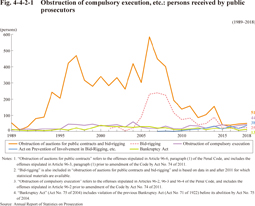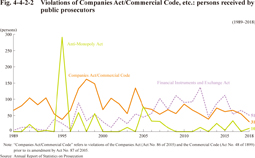Section 2 Economic Offenses
Fig. 4-4-2-1 shows the trend in the number of persons received by public prosecutors for obstruction of compulsory execution (offenses stipulated in Articles 96-2, 96-3 and 96-4 of the Penal Code including the offense stipulated in Article 96-2 of the Penal Code prior to its amendment by Act No. 74 of 2011), obstruction of auctions for public contracts, bid-rigging and violations of the Bankruptcy Act (Act No. 75 of 2004) (including Act No.71 of 1922 prior to its abolition under Act No. 75 of 2004) and Act on Elimination and Prevention of Involvement in Bid Rigging, etc. and Punishments for Acts by Employees that Harm Fairness of Bidding, etc. (Act No. 110 of 2006; hereinafter referred to as “Act on Elimination of Bid-rigging”) .
Fig. 4-4-2-1 Obstruction of compulsory execution, etc.: persons received by public prosecutors
Fig. 4-4-2-2 shows the trend in the number of persons received by public prosecutors for violations of the Companies Act (Act No. 86 of 2005)/Commercial Code (Act No. 48 of 1899, prior to its amendment by Act No. 87 of 2005), the Act on Prohibition of Private Monopolization and Maintenance of Fair Trade (Act No. 54 of 1947; hereinafter referred to as the “Anti-Monopoly Act”), and the Financial Instruments and Exchange Act (Act No. 25 of 1948; the Act was titled “Securities and Exchange Act” prior to its amendment on September 30, 2007).
Fig. 4-4-2-2 Violations of Companies Act/Commercial Code, etc.: persons received by public prosecutors
Fig. 4-4-2-3 shows the trend in the number of persons received by public prosecutors for violations of the Act Regulating the Receipt of Contributions, the Receipt of Deposits, and Interest Rates (Act No. 195 of 1954; hereinafter referred to as “Investment Act”) and the Money Lending Business Act (Act No. 32 of 1983; the Act was titled “Loan Business Control Act” prior to its amendment on December 19, 2007).
Fig. 4-4-2-3 Violations of Investment Act, etc.: persons received by public prosecutors


